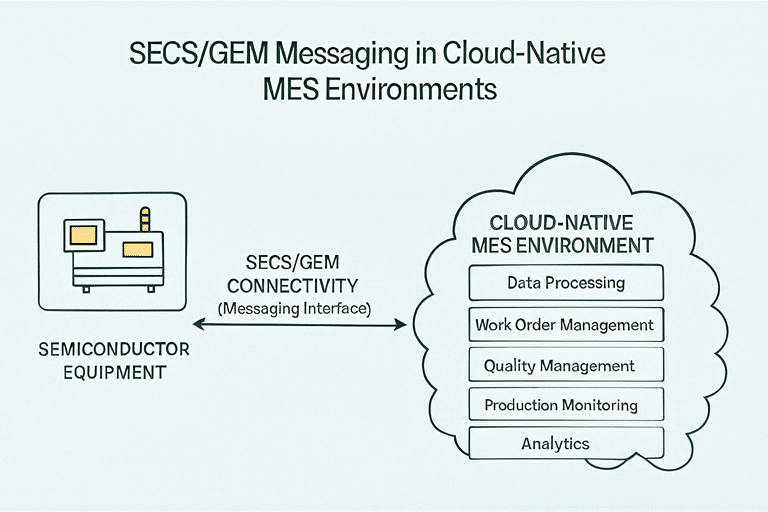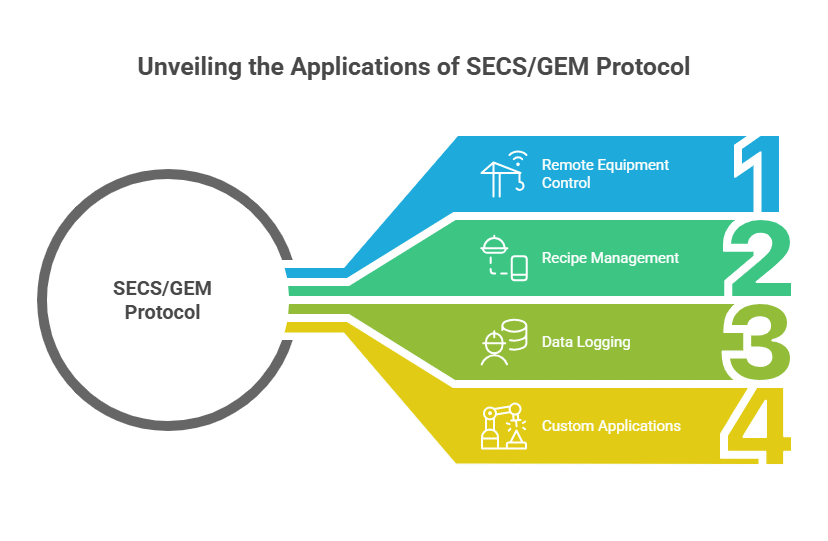
The semiconductor industry is undergoing a significant transformation. As fabs move toward cloud-native MES (Manufacturing Execution Systems), the role of SECS/GEM messaging becomes even more critical in enabling seamless communication between equipment and factory automation systems. With increased demands for efficiency, flexibility, and scalability, choosing the right approach to SECS/GEM integration is vital for modern fabs.
In this blog, we explore how SECS/GEM software supports cloud-native MES, why semiconductor MES automation depends on it, and how both legacy and modern tools can benefit from SECS/GEM protocol in MES environments.

The Evolution of MES and the Role of SECS/GEM
Traditional MES platforms were designed to operate on-premises, tightly integrated with equipment and host systems. However, as the industry embraces cloud-native MES environments, new challenges emerge around connectivity, scalability, and security.
Here, SECS/GEM integration ensures standardized communication between tools and the MES, regardless of whether the system is running in a data center, private cloud, or hybrid cloud environment.
SECS/GEM software enables equipment to send and receive structured messages.
Cloud-based SECS/GEM communication ensures that the same standards are applied, even in distributed architectures.
MES with SECS/GEM support future-proofs fabs by allowing legacy equipment to operate alongside modern 300mm tools.
Without robust SECS/GEM application development, fabs risk misaligned communication protocols that can lead to downtime, inefficiency, and data loss.
Why SECS/GEM Integration Matters in Cloud-Native MES
In traditional fabs, SECS/GEM protocols were used to connect equipment directly to on-premises MES or host computers. In cloud-native MES environments, however, connectivity is more complex, involving distributed data flows and multi-cloud systems.
SECS/GEM integration in this context provides several key benefits:
Standardized Messaging – Whether equipment is legacy or modern, SECS/GEM ensures consistent communication.
Real-Time Visibility – With semiconductor MES automation, fabs gain real-time monitoring of process performance, alarms, and yield metrics.
Scalable Data Handling – Cloud-based SECS/GEM communication allows data from multiple sites to be aggregated and analyzed centrally.
Interoperability – MES with SECS/GEM support enables different vendors’ tools to integrate seamlessly.
By leveraging SECS/GEM software, fabs not only streamline operations but also lay the foundation for advanced analytics, predictive maintenance, and AI-driven process control.
SECS/GEM Protocol in MES: Practical Applications
Modern fabs are increasingly focused on flexibility—supporting both leading-edge technologies and legacy processes. The SECS/GEM protocol in MES environments addresses this challenge directly by providing a standardized way to manage tool communication.
Some practical applications include:
Remote Equipment Control – Operators can start, stop, and monitor processes from cloud-hosted MES dashboards.
Recipe Management – Equipment automation with SECS/GEM ensures consistency across different tools and production sites.
Data Logging – Centralized data collection improves defect detection and yield tracking.
Custom Applications – Through SECS/GEM application development, fabs can build tailored interfaces, predictive systems, and analytics tools.
This makes SECS/GEM integration not just a technical necessity, but a strategic enabler for modern fab competitiveness.

Overcoming Challenges in Cloud-Based SECS/GEM Communication
Moving SECS/GEM messaging into the cloud introduces new complexities. Latency, data security, and integration with legacy equipment must all be addressed.
Latency Control – SECS/GEM software must be optimized to ensure real-time response even in cloud environments.
Data Security – Encryption and access control are critical when implementing cloud-based SECS/GEM communication.
Legacy Integration – Many fabs rely on older tools. With MES with SECS/GEM support, even 200mm equipment can be integrated into cloud MES systems.
Scalability – As fabs grow, semiconductor MES automation powered by SECS/GEM ensures new tools can be added without major reconfiguration.
By deploying the right SECS/GEM integration services, these challenges can be minimized while unlocking the full potential of cloud-native MES.
Future of SECS/GEM in Cloud MES Environments
The adoption of cloud-native MES represents a fundamental shift for semiconductor manufacturing. SECS/GEM messaging will continue to be the backbone of this transformation, ensuring smooth communication and interoperability.
Key trends to watch include:
AI/ML Integration – Using SECS/GEM software data streams for advanced analytics and predictive maintenance.
Multi-Site Automation – Standardized protocols enable global fabs to operate under a unified MES framework.
Hybrid Architectures – Combining on-premises systems with cloud-based SECS/GEM communication for maximum flexibility.
As fabs continue to evolve, SECS/GEM application development will remain central to enabling innovative, efficient, and scalable automation.
The shift to cloud-native MES environments is redefining how fabs approach automation. At the heart of this transformation lies SECS/GEM integration, providing standardized messaging, real-time visibility, and interoperability across diverse equipment.
With the right SECS/GEM software and MES with SECS/GEM support, semiconductor manufacturers can seamlessly integrate legacy and modern tools, improve yields, and reduce downtime.
In short, SECS/GEM messaging is more than a protocol—it is the foundation of semiconductor MES automation in the cloud era, enabling fabs to stay agile, competitive, and future-ready.
More Blog Posts
- Where Can I Find Experts for SECS/GEM Software Integration?
- How does SECS/GEM facilitate communication in smart factories
- How does SECS/GEM benefit semiconductor manufacturing processes
- How SECS/GEM Host Simulators are Transforming Factory Automation
- Why SECS/GEM Protocol is the Backbone of Semiconductor Equipment Communication

